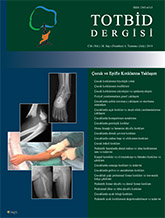
Distal radius and ulna fractures are quite common in children and adolescents. In the approach to these fractures, the neurovascular status of the related extremity, presence of soft tissue injury, and most importantly, the presence of physis injury of the radius and ulna should be clarified. The treatment of these fractures may vary from simple reduction and cast immobilisation to urgent reduction and surgical fixation. Regardless of the initial treatment, the most important point for orthopedic surgeon is early or late complications which may affect the treatment results. These complications include growth arrest which is the result of physis fractures, acute compartment syndrome, malunion which are requiring special attention and follow-up. The patient and parents want to return to their daily activities quickly. However, it is essential for the limb to receive adequate treatment to achieve long-term functionality. Another important task of the orthopedic surgeon is to balance of these two demands. Many studies discuss appropriate treatment modalities for specific types of fractures. There are significant differences between clinicians in their approach to such fractures. This paper aims to draw attention to the management of pediatric distal forearm fractures and possible complications together in the light of the current literature.